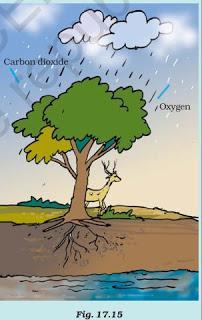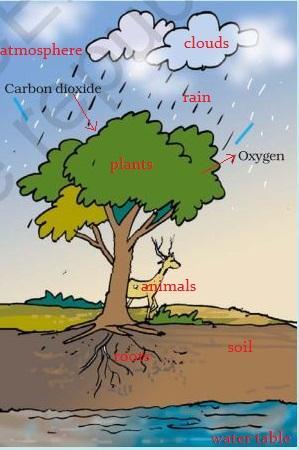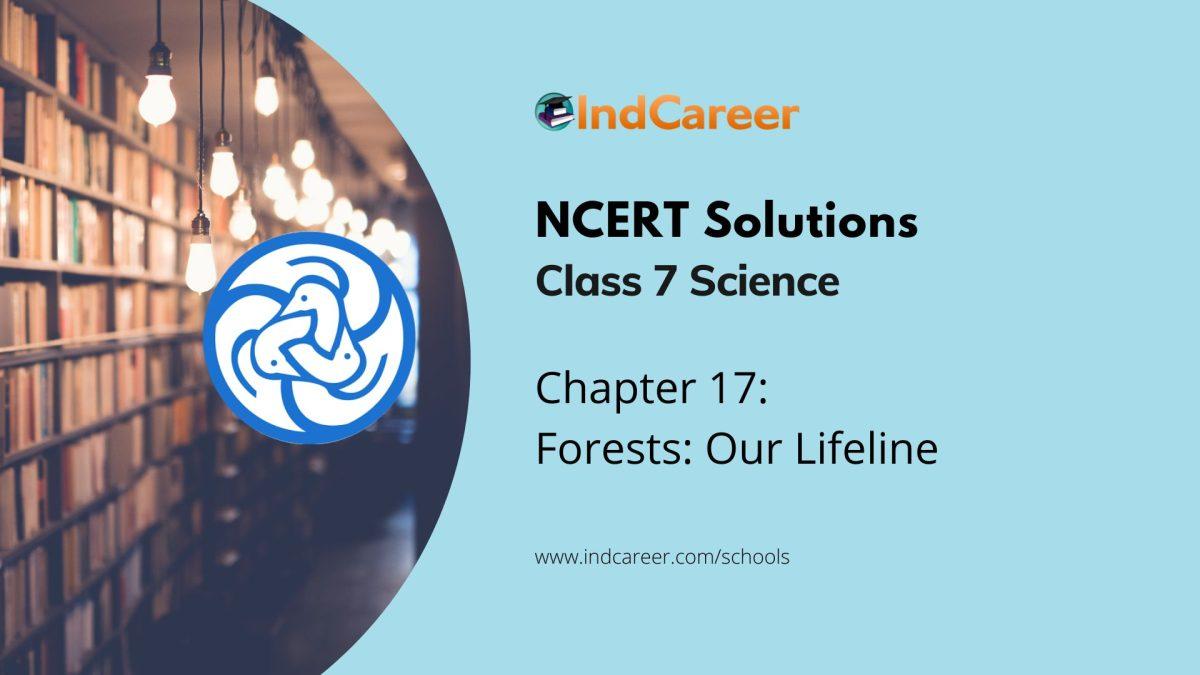Class 7: Science Chapter 17 solutions. Complete Class 7 Science Chapter 17 Notes.
Contents
NCERT Solutions for 7th Class Science: Chapter 17-Forests: Our Lifeline
NCERT 7th Science Chapter 17, class 7 Science Chapter 17 solutions
Page No: 217
Exercises
1. Explain how animals dwelling in the forest help it grow and regenerate.
Answer
Animals dwelling in the forest help in various way for growth and regenerate. Some of them are:
(i) Herbivores animals clear the land by eating grass for the new growth of vegetation.
(ii) Animals also help in the seed dispersal and pollination.
(iii) Dead and decaying bodies of animals convert to humus after decomposition which increase the fertility of the soil of the forest.
(iv) Dungs of animals provide nutrient to various types of seedling to grow.
2. Explain how forests prevent floods.
Answer
Forest acts as a natural absorber of rainwater and allows it to seep. It helps in controlling the flow of water and slows it down which helps in preventing flood. Also, the trees present in the forest prevents the rain from directly hitting the ground and bind the soil together which helps in absorption of the rain water and thus prevent flood.
3. What are decomposers? Name any two of them. What do they do in the forest?
Answer
The micro-organisms which convert the dead plants and animals to humus are known as decomposers.
Bacteria and fungi are the two examples of decomposers.
They play an important role in the decomposition of dead remains of the plants and animals
and converting them to humus which add nutrient to the soil.
4. Explain the role of forest in maintaining the balance between oxygen and carbon dioxide in the atmosphere.
Answer
Forest play an important role in maintaining the balance between oxygen and carbon dioxide in the atmosphere. The green plants and trees present in the forest take in carbon dioxide which is released by the animals and release oxygen through the process of photosynthesis which are breathe in by the animals and thus maintains the balance between oxygen and carbon dioxide in the atmosphere.
5. Explain why there is no waste in a forest.
Answer
There is no waste in a forest because whatever produced here are utilized by the other organisms or plants for sustainability. Even the waste materials and dead remains which are produced are bodegradable and converted into humus which returns back the nutrient back to the soil.
6. List five products we get from forests?
Answer
Five products we get from forests are:
(i) Wood
(ii) Resins
(iii) Gum
(iv) Honey
(v) Medicines
Page No: 218
7. Fill in the blank:
(a) The insects, butterflies, honeybees and birds help flowering plants in ___________ .
(b) A forest is a purifier of _____________ and _______________ .
(c) Herbs form the ______________ layer in the forest.
(d) The decaying leaves and animal droppings in a forest enrich the ______________ .
Answer
(a) The insects, butterflies, honeybees and birds help flowering plants in pollination.
(b) A forest is a purifier of water and air.
(c) Herbs form the lowest layer in the forest.
(d) The decaying leaves and animal droppings in a forest enrich the soil.
8. Why should we worry about the conditions and issues related to forests far from us?
Answer
We should worry about the conditions and issues related to forests far from us because more or less we are dependent on it because:
(i) The amount of carbon dioxide in air will increase if forest will disappear and thus less oxygen in atmosphere o breathe in.
(ii) There will be more soil erosion and thus increase in floods as soil will not able to hold water.
(iii) Increase in the percentage of carbon dioxide will also leads to global warming.
(iv) Deforestation will endanger our life and environment and also there will be no shelter for animals.
(v) There is also imbalance in nature and thus causing climate changes and less rainfall.
9. Explain why there is a need of variety of animals and plants in a forest.
Answer
There is a need of variety of animals and plants in a forest as each of them contribute their for maintaining the ecosystem of the forest. It also helps forest in regeneration and growth. Herbivores are needed to eat green plants and to provide food for the carnivores and Carnivores are needed to eat herbivores and check their population. Also, decomposers are needed to maintain the supply of nutrients to the soil and to the growing plants.
10. In Fig. 17.15, the artist has forgotten to put the labels and directions on the arrows. Mark the directions on the arrows and label the diagram using the following labels:
clouds, rain, atmosphere, carbon dioxide, oxygen, plants, animals, soil, roots, water table.

Answer

11. Which of the following is not a forest product?
(i) Gum
(ii) Plywood
(iii) Sealing wax
(iv) Kerosene
► (iv) Kerosene
12. Which of the following statements is not correct?
(i) Forests protect the soil from erosion.
(ii) Plants and animals in a forest are not dependent on one another.
(iii) Forests influence the climate and water cycle.
(iv) Soil helps forests to grow and regenerate.
► (ii) Plants and animals in a forest are not dependent on one another.
Page No: 219
13. Micro-organisms act upon the dead plants to produce
(i) sand
(ii) mushrooms
(iii) humus
(iv) wood
► (iii) humus
NCERT 7th Science Chapter 17, class 7 Science Chapter 17 solutions
NCERT Solutions for 7th Class Science: Chapter 17: Download PDF
NCERT Solutions for 7th Class Science: Chapter 17-Forests: Our Lifeline
Download PDF: NCERT Solutions for 7th Class Science: Chapter 17-Forests: Our Lifeline PDF
Chapter-wise NCERT Solutions Class 7 Science
About NCERT
The National Council of Educational Research and Training is an autonomous organization of the Government of India which was established in 1961 as a literary, scientific, and charitable Society under the Societies Registration Act. Its headquarters are located at Sri Aurbindo Marg in New Delhi. Visit the Official NCERT website to learn more.
